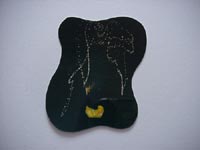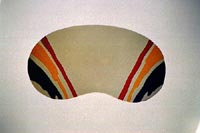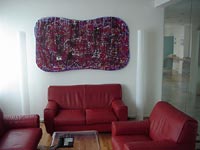
"NOCTURNE"
94x74cm, 2000
| Morphism also appears as an appeal to the painter who is readily using the rectangular format without questioning it. The rectangular canvas is certainly convenient to use, but it’s short of one expressive option: with its carefully designed contours Morphism adds an extra dimension to the flat picture plane. As such it yields an excellent opportunity to revive previous art without merely copying it.
Earlier movements like touchism, minimalism, elementarism or suprematism are readily, and with distinctive character, applied to Morphism. However by doing so a gain in the expressiveness of the picture’s format will result in a loss of a traditional standard. (Society sometimes welcomes new standards as a refreshing change. But it is more likely that the artist is viewed with disfavour for shattering what is familiar and beloved). Morphism is meant to set a new standard in canvas design. A standard that fits nicely into the twisted shapes and irregular spaces of modern building design. By abandoning the rectangular picture format in exchange of unconventional design and seeming randomness, Morphism adapts the deconstructive character that is special to turn-of-the-century, avant-garde architecture. Actually, Morphism renounces rectilinear purism to any envirement and embraces the irrational as an esthetic. It’s a new approach to painting.
Above all it’s a personal stile.
| 
"A MORPHISTIC QUOTE TO MORRIS LOUIS
170x108cm, 2000 |



